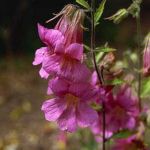| Common Name: |
Chinese Foxglove |
| Botanical Name: |
Rehmannia glutinosa |
| Genus: |
Rehmannia |
| Family Name: |
Scrophularaceae |
| Native Location: |
N China |
| Cultivation: |
Light, moist, well-drained, rich, neutral to acid, sandy soil in sun. Plants are prone to fungal infections, especially in damp conditions. |
| Propagation: |
By seed sown in late winter at 13-16°C (55-61°F); by root cuttings in late autumn; by softwood cuttings of basal shoots in spring. |
| Harvest: |
Roots are lifted in autumn and eraly winter (cultivated crop), or early spring (wild plants), and used fresh or dried (sheng di huang), for use in decoctions, extracts, pills, powders, and tinctures, or steamed in rice wine (shu hi huang). |
| Height: |
15-30cm (6-12in) |
| Width: |
30cm (12in) |
| Hardiness: |
Z8-10 |
| Properties: |
A sweet, cooling (sheng di huang) to slightly warming (shu di huang) herb that controls bleeding, lowers fever, reduces blood sugar, and has diuretic and anti-bacterial effects (sheng di huang). It acts as a tonic for the heart, blood, and kidney energy, regulates menstruation, and strengthens women after childbirth (shu di huang). |
| Medicinal Uses: |
Internally for thirst associated with feverish illnesses, heat rash, hemorrhage of all kinds, excessive menstruation, and diabetes (sheng di huang); anemia, night sweats, menopausal problems, weakness following childbirth, and involuntary ejaculation (shu di huang). Often combined with Angelica polymorpha var. sinesis (See, Chinese Angelica), the peel of Citrus reticulata (See, Mandarin Orange), and Ziziphus jujuba (See, Chinese Date). |
| Warning: |
Not given to patients with digestive problems. |
| Parts Used: |
Roots (di huang) |
| Bibliography: |
Encyclopedia of Herbs ~ Deni Bown ~ Copyright © 1995, 2001, Doring Kindersley Limited ~ pp. 341-342 |

